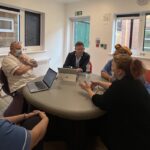Help shape the future of Mental Health Act digitisation
Why Steering Groups matter
The Thalamos mission is to make access to, receipt of, and discharge from, acute mental healthcare, swifter, simpler and safer. We achieve this by creating digital enablers which support health and social care professionals to better care for their patients. Better patients outcomes are at the centre of everything we do.
We have the somewhat paradoxical goal of applying technology to make mental healthcare more human. To deliver on this goal we must ensure that our software is simple, intuitive and aligned with human needs for those who use it. To achieve this, we must seek to fully understand those potential users and include them in the design, build and improvement processes.
The Thalamos Steering Groups are designed to do exactly this. They exist to inform, guide and to course correct the evolution of Thalamos products, ensuring they are aligned to the specific and nuanced requirements of individual users.
A direct way to influence the software you use
1. Designed by the experts
• Steering Groups ensure Thalamos evolves based on real-world user needs, not assumptions
2. Making digital mental health care more human
• We use technology to simplify processes so you can focus on patient care
3. Directly shape the future of Thalamos
• Your feedback turns into real product improvements, helping you work more effectively
4. National alignment on key challenges
• By bringing together professionals in the same role but in a different organisations, Steering Groups ensure national sentiments are heard
Who can join
Our Steering Groups are designed to generate feedback from core product user groups. By bringing together individuals and teams with similar challenges and ways of working we can generate insights that help with specific parts of product development.
How Steering Groups have shaped the future of Thalamos products
Thalamos users have firsthand knowledge of how our tools fit into ways of working. Steering Groups give a direct way to request and shape improvements.
How to get involved
1. Sign up — Express interest via our short form
2. Meet with group — We’ll invite you to a 90-minute quarterly session to explore ideas and challenges
3. Directly influence product development — Request changes, test features, and suggest improvements
4. See the impact — Your feedback directly influences our product roadmap and helps put the right digital tools in your hands



